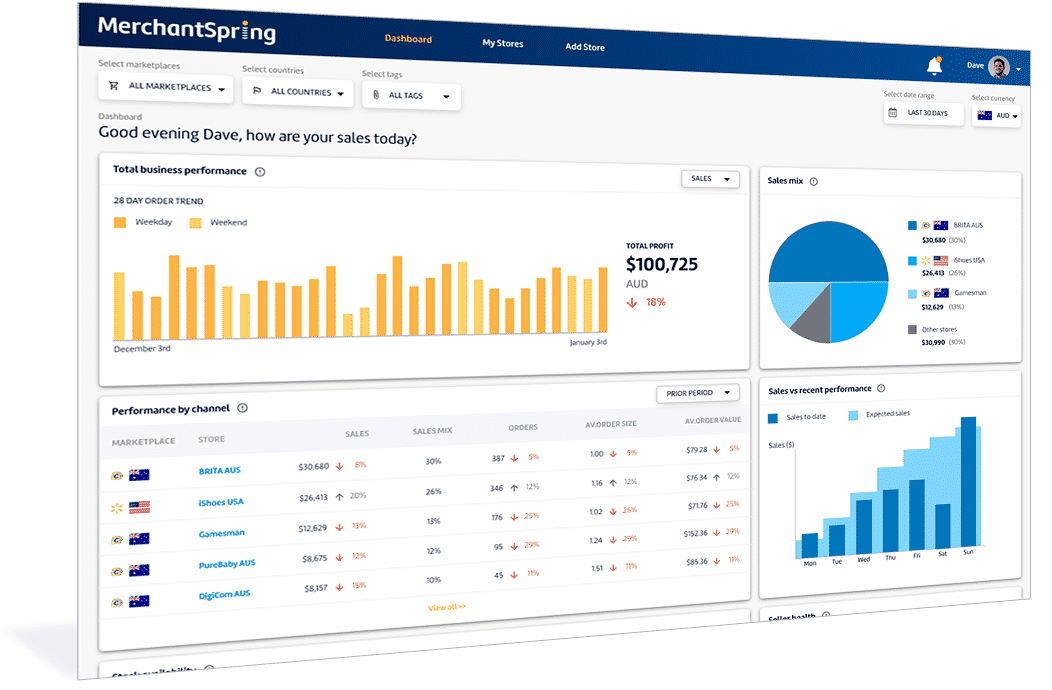The One-Person Amazon Agency: Growth Without Hiring
Overview
In the fast‑moving world of Amazon agencies, growth is often equated with headcount. Founders hire account managers, ad specialists and analysts in the belief that scaling means adding people. Yet the episode of the Marketplace Masters webinar featuring Aaron Moore, the founder of Moore Growth, challenges that assumption. Moore operates a one‑person Amazon agency that manages some of the largest and most complex Amazon vendor accounts. Instead of adding bodies, he has built a lean operational machine around systems, automation and ruthless focus. His story shows that “scaling” doesn’t always mean hiring – it can mean doing more with less and doing it better. This article synthesises the key insights from the webinar, overlays best‑practice research and proposes practical strategies for Amazon agency professionals who want to maximise growth without blowing up their headcount.
The myth of scale – headcount isn’t always the answer
The default playbook for many agencies is to recruit as soon as revenue grows. But scaling purely by hiring can backfire. Building an in‑house Amazon team is costly and time‑consuming – you need multiple experts across listings, advertising, design and analytics, and someone to manage them. The digital growth agency beBOLD argues that recruiting and training a competent Amazon team is “onerous” and expensive; agencies often achieve more with fewer people because they spread specialist knowledge and tools across multiple clients. These costs are magnified when replacing staff or dealing with cultural misfits.
Besides the direct costs, there is hidden risk in ramping up headcount too quickly. Geeks for Growth notes that scaling an agency without the right infrastructure leads to burnout and client churn. Recruiting full‑time staff is a lengthy process and contractors often deliver inconsistent results. Agencies that “promise big but deliver slowly” lose their competitive edge and risk losing clients. The article suggests white‑label partnerships as an alternative – instead of hiring, agencies can temporarily expand capacity by partnering with experts who work behind the scenes, providing predictable pricing and deliverables without HR headaches.
Taken together, the research shows that headcount growth is not synonymous with success. Lean agencies minimise fixed costs, avoid the management burden of large teams and stay nimble when clients or market conditions change. A solo founder can earn more per client and reinvest in technology rather than payroll. Moore’s story illustrates these benefits in practice.
The lean advantage – speed, precision and continuous improvement
Lean operations aren’t just a buzzword; they are a philosophy of doing more with less. Lean organisations focus relentlessly on customer value and continuous improvement, eliminating waste and inefficiency. By shrinking processes to the essentials, lean companies become agile and responsive. The Lean Enterprise Institute summarises it as “doing the right thing, in the right place, at the right time, in the right quantity”. In an Amazon context, this translates into precise inventory management, streamlined advertising, data‑driven listing optimisation and rapid response to customer feedback.
Aaron Moore embodies lean thinking. He explained that the greatest advantage of a one‑person agency is speed. Without layers of management, approvals or cross‑departmental hand‑offs, he can act quickly when an opportunity appears or a problem arises. “Speed and precision allow for the greatest sales and influence on Amazon,” he said during the webinar. Opportunity on Amazon is fleeting; a spike in demand or a competitor’s stock‑out can disappear in hours. Larger agencies may convene meetings before deciding on new keywords or adjusting bids. A solo operator can make decisions on the fly.
Moreover, lean operations force clarity. Moore emphasised the “beautiful, boring basics” – focusing on fundamental tasks like restocking, advertising optimisation and listing improvements, then executing them consistently. Lean is not about doing less; it is about doing only what matters and doing it faster and better. For agencies, this means building repeatable systems, automating reporting and freeing up time to think strategically for clients.
Systems and workflows: how a solo agency manages enterprise accounts
One of the most common questions Moore receives is “How do you handle all that work on your own?” The answer is systems and discipline. Below is a breakdown of the weekly cadence he shared and practical strategies that other agencies can adapt.
1. Monday - reporting and alignment
Monday is reserved for a comprehensive health check. Moore uses third‑party reporting tools to generate an eight‑page Key Performance Indicator (KPI) report tailored to each stakeholder – executives, sales managers and marketers. He sends a situation report (sit‑rep) summarising the performance of each account and listing what he has accomplished and what he will work on next. This pre‑emptively addresses questions and aligns expectations.
2. Tuesday - restocking and inventory management
In-stock availability is a major driver of Amazon sales. Research from the Accrue Agency highlights that vendor managers must align supply with demand, forecasting peaks and ensuring compliance with Amazon’s strict shipping, packaging and labelling guidelines. Moore dedicates Tuesdays to reviewing 90‑day inventory levels for every SKU, monitoring restock limits and placing purchase orders. This proactive approach reduces out‑of‑stocks and avoids Amazon chargebacks for late or incomplete shipments.
3. Wednesday - advertising optimisation
Effective advertising fuels growth but can also drain cash. Moore uses Wednesday to monitor advertising campaigns, adjusting bids and keywords to maintain his North Star metrics: a TACoS (total advertising cost of sales) around 10 % and a 4× return on ad spend. Lean agencies should focus on efficiency rather than volume. Regularly reviewing search query performance allows you to identify keywords that drive conversions and cut wasteful spend. Negative keywords and rule‑based automation can keep campaigns in check.
4. Thursday to Sunday - listing optimisation and experimentation
With inventory and ads in order, the rest of the week is for optimisation. Here, Moore applies a surprisingly simple yet powerful framework: the voice of the customer. On Mondays, he reviews every customer complaint, return reason and Q&A to identify pain points. These insights guide his optimisation priorities – whether rewriting bullet points, adding images or creating a product video. By responding directly to customer feedback, he pre‑empts negative reviews and improves conversion rates. This practice aligns with research showing that vendor managers should invest in analytics and respond to consumer metrics to improve performance.
Moore also uses ChatGPT as a writing assistant. He feeds the AI with the current bullet points, the list of top converting keywords (pulled from Amazon’s Search Query Performance report) and the specific customer complaints. He instructs the tool to generate new bullets of 240–250 characters that address the negatives and incorporate key terms. He then reviews and polishes the output before posting. While AI is not a replacement for expertise, it accelerates copywriting for lean teams.
5. Tools and tech stack
Apart from third‑party reporting, Moore’s stack is intentionally minimal. He uses Apple Notes as his workflow software – each client has a dedicated note containing tasks, contacts, addresses and updates. For design, he uses Canva to quickly refresh images. He also leverages password managers and Amazon’s user permissions to manage multiple accounts securely. Because there is no team to route tasks through, complex project management tools are unnecessary. Agencies with larger teams might need Asana or ClickUp; solo operators can thrive with lightweight tools.
6. The Pomodoro approach to management
Running a one‑person agency requires ruthless focus. Moore works in 20‑minute increments using a physical egg timer. The technique is reminiscent of the Pomodoro Method, where you work on a single task for 25 minutes followed by a short break. Studies of the Pomodoro Technique show that it helps maintain focus, prevents burnout and boosts motivation. After four sessions, you take a longer break, allowing your brain to recover. Whether you follow 20‑minute or 25‑minute intervals, the principle is the same: break work into focused sprints with deliberate rest.
Managing complexity – multiple accounts, vendor management and compliance
Some might assume that a one‑person agency is only viable for small sellers. Moore’s client portfolio proves otherwise. He manages enterprise vendor accounts, some with hundreds of SKUs and millions in annual sales. Handling multiple accounts comes with unique challenges:
Securely Managing Many Amazon Accounts
Amazon’s user‑permission system allows a single email to manage up to 100 seller accounts. The My Amazon Guy blog warns that if multiple accounts are linked incorrectly, Amazon may suspend them. Agencies should set up separate business entities, bank accounts and tax IDs for each client. Use password managers like 1Password to store credentials and one‑time passwords, and avoid sharing login details via unsecured channels. These precautions keep client data safe and reduce the risk of account suspension.
Understanding Vendor Management Dynamics
Agencies that manage 1P (vendor) accounts need a different skill set from 3P sellers. Vendor managers act as a liaison between the supplier and Amazon. They are responsible for onboarding vendors, forecasting demand, ensuring compliance with packaging and shipping standards, and negotiating marketing terms. Challenges include stringent compliance requirements, volatile demand and price pressures from Amazon. Best practices recommended by the Accrue Agency include investing in analytics dashboards to monitor sales and inventory, streamlining logistics with efficient fulfilment networks, engaging in strategic promotions like Lightning Deals, prioritising compliance through internal SOPs, and maintaining open communication with Amazon contacts.
For a solo agency, these responsibilities may seem daunting. However, lean operations combined with automation can help. Reporting platforms aggregate sales, advertising and inventory data into a single dashboard. Automated replenishment alerts warn you when stock is low. Use EDI or API connections (often provided by vendor central integrations) to automate purchase order processing. By automating routine tasks, a one‑person agency can focus on high‑impact actions like negotiation, campaign strategy and product development.
Business development and marketing – building a pipeline without cold outreach
Moore’s approach to acquiring clients is as deliberate as his operational model. Rather than cold‑calling or blasting emails, he focuses on inbound marketing via LinkedIn:
- Coffee & Commenting. Every morning, he spends the first hour responding thoughtfully to LinkedIn messages and comments. He uses the insights gained to craft new posts, creating a virtuous loop of engagement.
- Daily content. He publishes at least one post per day about Amazon trends, case studies or lessons learned. This consistent value attracts Amazon brand owners and decision makers, who reach out when they need help.
- Leveraging referrals. A smaller portfolio allows for deeper relationships. Happy clients refer other brands, reducing the need for outbound sales.
- Qualifying prospects. When a large brand expresses interest, Moore asks probing questions to understand their pain points. He then explains how a solo setup can deliver speed, personal attention and holistic account knowledge. If his calendar is full, he is transparent about start dates or declines the project. This honesty builds trust.
In a market crowded with agencies, authenticity and thought leadership stand out. Agencies considering this model should invest in content marketing, webinars and case studies. They should also set clear client criteria; not every lead is a good fit for a lean agency. Dropping late‑paying or uncooperative clients frees capacity for high‑quality opportunities.
Mindset and work‑life integration – execution over balance
One of the most striking statements from the webinar was Moore’s remark: “There is no balance in my life, just execution.” Although he was partly joking, his point was serious: focus and deliberate rest trump the vague notion of work‑life balance. He structures his day around intense execution cycles, followed by purposeful breaks, doing something that absorbs his attention. For him, playing pickleball or golf forces him to be present and clears his head of TACoS and KPIs. Similarly, if you prefer weightlifting or cycling, push yourself hard enough that you cannot ruminate about work.
The Pomodoro Technique and its variants support this approach by breaking work into manageable segments with scheduled breaks. Lean agencies should encourage such practices to avoid burnout, especially when one person is juggling many responsibilities. Intense focus combined with complete detachment during breaks leads to sustainable productivity.
Evaluating whether staying boutique is right for your agency
Lean, boutique agencies are not the right fit for every business. When deciding whether to grow headcount or stay small, consider the following factors:
- Client mix and revenue concentration. If your clients are stable, high‑revenue brands, a solo model can be lucrative. If you rely on many small clients with unpredictable needs, adding support may provide redundancy.
- Service scope. Do clients expect you to handle creative, paid media, catalogue expansion, international expansion and analytics? A solo operator can cover core tasks but may need partners for specialised services such as design or translation. White‑label partnerships can fill gaps without permanent hires.
- Risk tolerance. Being a one‑person business exposes you to health or personal emergencies. Consider building a trusted network of freelancers or agencies you can call on in case you are unavailable.
- Personal goals. Some founders thrive on managing teams and enjoy building organisational culture. Others prefer deep work and minimal management. Choose the model that aligns with your strengths.
Ultimately, staying boutique is about aligning your business model with the value you deliver. The research shows that a lean, customer‑centric operation can be more profitable and agile than a bloated agency. As long as you invest in the right systems and relationships, you can scale revenue without adding headcount.
Conclusion and next steps
The Marketplace Masters webinar with Aaron Moore demonstrates that scaling an Amazon agency does not require an ever‑growing payroll. By adopting a lean mindset, focusing on high‑leverage activities and investing in systems, a single operator can manage enterprise accounts, deliver exceptional results and enjoy healthy margins. Research from across the e‑commerce and operations fields supports this approach – lean operations improve efficiency and agility, while overhiring creates costs and risks. With smart workflows, secure account management, customer‑driven optimisation and disciplined time management, a one‑person agency can achieve remarkable scale.
If this discussion resonates with you, watch the full webinar to hear Aaron’s insights firsthand. You can also subscribe to our Markeplace Masters series for more agency best practices and connect with us on LinkedIn. Whether you’re considering staying solo or building a small team, the principles of lean growth – speed, precision and continuous improvement – will serve you well on Amazon.


%204-Sep-08-2025-02-47-04-6925-AM.png)











Add a Comment